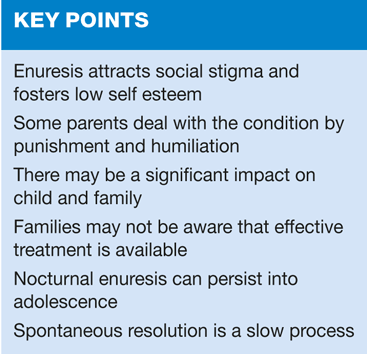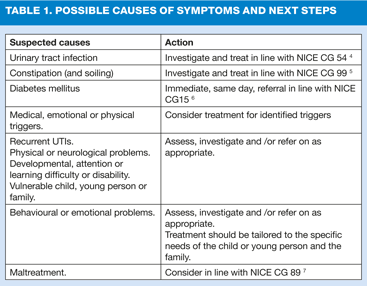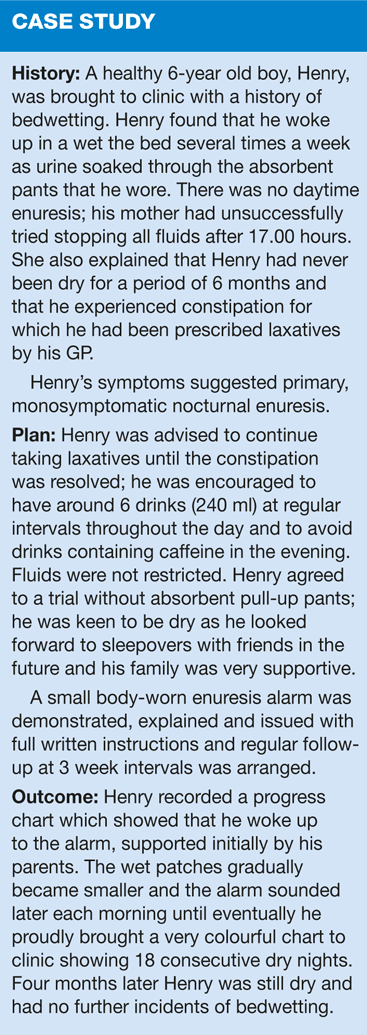Nocturnal enuresis in children and adolescents
Phil Prynn
Phil Prynn
RGN, ONC, PGC, B.A. (Hons),
Cert. Ed Caversham, Berkshire
Bedwetting is a distressing condition both for children, especially if it persists into early school years, and for parents. Although many children will eventually 'grow out of it' practice nurses can offer practical help
Nocturnal enuresis (NE), or bedwetting, is a common occurrence in children. It is not a serious medical disorder, but most enuretic children feel shamed, embarrassed and isolated. NE is likely to have a negative impact on everyday family life and the child may be affected socially, emotionally, and behaviourally. Psychological problems are thought to be a result rather than a cause of bedwetting.
DEFINITION
NE can be defined as the involuntary voiding of urine during sleep, in the absence of urinary pathology, and beyond the age at which bladder control usually occurs (generally considered to be around 5 years of age).1
- Primary nocturnal enuresis refers to a child who has never achieved consistent night-time bladder control.
- Secondary nocturnal enuresis is where bedwetting occurs in a child who has previously been dry for a period of at least 6 months.
- Monosymptomatic nocturnal enuresis is associated with a normal daytime voiding pattern, whilst non-monosymptomatic bed-wetting may be linked with urinary urgency, frequency and diurnal enuresis.
Prevalence
Bedwetting less than twice a week is reported as affecting 21% of four and a half year olds and 8% at nine and a half years. More frequent bedwetting is less common affecting 8% of four and a half year olds and 1.5% at nine and a half years.2 Although the incidence of bedwetting decreases as age rises, around 0.5- 1% of the adult population occasionally wets the bed. A family history of enuresis enhances the risk of NE in children.3
BLADDER FUNCTION
The bladder is a hollow organ designed to store urine. Social consciousness and the ability to void or inhibit voiding develop at around 2 - 3 years of age; parents often start toilet training at this time. The following calculation maybe used to measure a child's bladder capacity: (age + 1) x 30 (ml); thus the bladder of an 8 year old should be able to hold 270ml. An adult's capacity is around 400 - 600 ml. Urine production is reduced by about 50% at night in response to the circadian rhythm of the antidiuretic hormone (ADH). Though specific voiding frequency will vary for every child, generally speaking, a child can be expected to urinate every two to three hours; a normal voiding pattern, for children as well as adults, is four to seven times per day. This pattern will depend on the individual's activity level, diet, water intake, and the environment.
PATHOPHYSIOLOGY
Pathophysiological factors such as nocturnal polyuria, a low nocturnal bladder capacity and sleep arousal dysfunction, may trigger NE. Constipation can be an additional aggravating cause.
Nocturnal polyuria: there is normally a rise in the secretion of arginine vasopressin (AVP), the antidiuretic hormone (ADH) during sleep; this decreases urine production at night. If there is inadequate secretion of AVP this will mean that the individual produces increased levels of urine at night, the bladder's capacity to retain a large volume of urine until morning will be overwhelmed, and unless the child wakens to void the result will be a wet bed.
Low bladder capacity: reduced functional bladder capacity (the volume at which the bladder empties itself) can be a contributing factor in NE. The child or young person may need to void two or three times during the night, before the bladder is actually full; this is often accompanied by daytime symptoms of urinary urgency, frequency and incontinence.
Sleep: neither nocturnal polyuria nor diminished bladder capacity adequately explain why children with NE do not wake up to void. Although parents typically maintain that their children with nocturnal enuresis are deep sleepers, in fact enuresis can occur during any stage of sleep, thus it is the child's inability to be roused by the sensation of the need to void that contributes to bedwetting.
Constipation: constipation i.e. straining to pass large, hard stools less frequently than normal can contribute to the risk of NE. Impacted stools can create pressure on the bladder, reduce bladder capacity and blunt sensation; this often leads to daytime and nighttime enuresis.
ASSESSMENT AND INVESTIGATION
A general history should be taken followed by specific questions about the bedwetting. This differentiates between the otherwise healthy child and the child with underlying symptoms of constipation, infection or diurnal enuresis. Less common causes of NE include conditions such as abnormalities of the urinary tract, neurological conditions, and endocrine disorders e.g. diabetes.
If a child or young person presents with symptoms in Table 1, he or she should be investigated and/or referred on appropriately.1
To assess the underlying cause of enuresis (if there is one) and determine the most effective treatment plan, a chart detailing daily fluid intake, urinary frequency throughout the day and regularity of bedwetting episodes should be recorded. Underlying diseases that may cause nocturnal enuresis must be ruled out; the following must also be established:
- Has the child/young person previously been dry without assistance for at least six months?
- Has the bedwetting started suddenly after a previous history of dry nights?
- Has NE been persistent since early childhood?
- How many times a night does the child/young person wet the bed?
- How many times a week does NE occur?
- Does there seem to be a large volume of urine?
- Are there any daytime symptoms, such as, urinary frequency, urgency and/or incontinence?
- Is the child/young person constipated or incontinent of faeces?
- What is the daily fluid intake, in terms of type (e.g. caffeine drinks) and quantity?
- Are fluids restricted?
- Are there any known medical, physical or developmental abnormalities?
It is unnecessary to perform urinalysis routinely unless the following symptoms are present:1
- The bedwetting is of recent onset
- Daytime symptoms are present
- There are signs and symptoms of ill health
- There's a history, signs or symptoms suggestive of urinary tract infections (UTI)
- There are signs or symptoms which indicate diabetes mellitus
TREATMENT
Treatment must be tailored to the needs of the child/young person and his/her parents or carers. Younger children (under 7 years) must not be excluded from the management of NE on the basis of age alone. It should be explained that the enuretic child is not at fault, and that punishment and humiliation must be avoided in order to maintain the child's self-esteem, enhance social competence and school performance8 and minimise parental frustrations.
Advice
- Keep a drinking and voiding record; this will help to identify and address excessive or insufficient fluid intake as well as abnormal toileting patterns
- Avoid caffeine-containing fluids in the evenings
- Encourage the child/young person to empty the bladder before going to sleep
- Ensure easy access to the lavatory
- Small rewards may be negotiated for concordance with management e.g. drinking recommended levels of fluid during the day or using the lavatory before sleep1
- Protect the mattress with a waterproof sheet
- Suggest a trial without nappies or pull-ups
- Involve the child in the morning clean-up in a non-punitive manner
- Encourage the child/young person to bathe, shower or wash in the morning to avoid skin damage, odour, humiliation or teasing by siblings and/or classmates
Enuresis alarm
The ability of the child/young person and family to cope must be explored before prescribing an enuresis alarm. Bedwetting alarms alert the brain to the sensation of passing urine. In order to achieve this a sensor is attached to the child's snugly fitting underwear; the device will buzz or vibrate when a very small amount of urine hits the sensor. The child should be encouraged to wake up as soon as the alarm sounds (or vibrates), go to the lavatory, and empty any remaining urine. Parents must be prepared to help the child with this initially. Enuresis alarm therapy has around a 70% success rate and works best for motivated children and parents. Alarm treatment should be continued when early signs of success are evident e.g. smaller wet patches, waking to the alarm, the alarm going off later and fewer wet nights. The initial aim is for 14 consecutive dry nights.
Alarm treatment should be stopped if there are no early signs of response and it is considered inappropriate if bedwetting is very infrequent, if the parents/carers are expressing anger towards the child/young person or if they are finding it difficult to cope with the burden of bedwetting.
Arginine vasopressin
An antidiuretic hormone (ADH) analog, or arginine vasopressin (AVP), can resolve bedwetting by decreasing night-time urine production. Medication e.g. desmopressin can be administered just before bedtime; it comes either in tablet form which is swallowed, or as a melt tablet that dissolves on the tongue. Treatment should be stopped after three months, for one week, to review. Further prescriptions of desmopressin may be offered for recurring NE, and gradual withdrawal should be considered if using repeated courses. If there is no response after 28 days the dose may be increased. However, if there is little or no response, desmopressin may be discontinued and the child/young person should be referred for further review.
Although adverse side-effects are rare, the child/young person should be advised not drink any fluid beginning one hour before and eight hours after taking desmopressin.
Anticholinergics
Anticholinergic medication such as oxybutynin can help by reducing detrusor contractions and increasing bladder capacity. It has a role in NE when there are significant daytime symptoms suggesting an overactive bladder.
CONCLUSION
Nocturnal enuresis is a distressing, widespread and often misunderstood disorder. Treatment is warranted in those who are troubled by their symptoms so they may be identified at an early age in order to hasten a cure and spare them the psychosocial effects since spontaneous resolution is a slow process. There are safe and effective treatments available; the enuresis alarm is the most effective measure, with lower relapse rates, but drug treatment provides a valuable adjunct to this, especially in refractory cases. A combined therapy of the enuresis alarm and medication may be considered where monotherapy is ineffective.
REFERENCES
1. National Institute for Health and Clinical Excellence (NICE). Nocturnal enuresis; the management of bedwetting in children and young people.2010CG111
2. Butler RJ, Heron J (2008). The prevalence of infrequent bedwetting and nocturnal enuresis in childhood: A large British cohort. Scandinavian Journal of Urology and Nephrology 42: 257-64
3. von Gontard A, Eiberg H, Hollmann E, et al. Molecular genetics of nocturnal enuresis: linkage to a locus on chromosome 22. Scandinavian Journal of Urology and Nephrology Suppl. 1999; 202:76-80
4. National Institute for Health and Clinical Excellence (NICE). Urinary tract infection in children. 2007 CG 54
5. National Institute for Health and Clinical Excellence (NICE). Constipation in children and young people. 2010 CG 99
6. National Institute for Health and Clinical Excellence (NICE). Type 1 diabetes in children, young people and adults. 2004 CG 15
7. National Institute for Health and Clinical Excellence (NICE). When to suspect child maltreatment. 2009 CG 89
8. Landgraf JM, Abidari J, Cilento BG et al. Coping, Commitment and Attitude: Quantifying the Everyday Burden of Enuresis on Children and Their Families. Paediatrics 2004 113:2 334-344
Related articles
View all Articles



